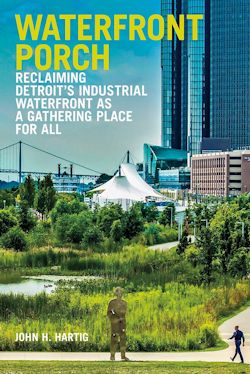SEJournal Online is the digital news magazine of the Society of Environmental Journalists. Learn more about SEJournal Online, including submission, subscription and advertising information.
BookShelf: ‘Waterfront Porch: Reclaiming Detroit’s Industrial Waterfront As a Gathering Place for All’
By John H. Hartig
Michigan State University Press, $24.95
Reviewed by Tom Henry
John Hartig is uniquely qualified to write “Waterfront Porch: Reclaiming Detroit’s Industrial Waterfront As a Gathering Place for All.”
 |
He’s an award-winning Great Lakes scientist, and he worked for years as the founding manager of the Detroit River International Wildlife Refuge — the world’s only wildlife refuge shared by two nations.
But he’s also the author of previous Great Lakes books and a Great Lakes historian with a long and enduring passion for Detroit, where he’s lived much of his life.
Full Disclosure: I’ve known Hartig for about 25 years, and can attest to how his balanced perspective and depth of knowledge has helped many reporters, me included. Besides the Society of Environmental Journalists, he’s worked with reporters through the Institute for Journalism & Natural Resources.
This book offers a positive, forward-moving outlook for Detroit’s long-neglected waterfront and its associated tributaries, including the heavily industrialized Rouge River.
Perhaps most importantly for journalists, it gives a thorough look at the Detroit River’s environmental problems and its history of abuse.
Detroit River a key shipping link
The Detroit River, for the uninitiated, is a long, swift-moving connecting channel between Lake St. Clair and western Lake Erie.
It has a powerful current, so strong that scientists view it as three rivers in terms of hydrology and have said it can be a difficult river to pull samples from because of how water flows so swiftly.
When people think of Detroit’s pollution legacy,
they often think of the automotive industry.
It is one of the Great Lakes regions most important links for shipping. It is known mostly for its heavy industry and urban impacts (more on that below), but, as Hartig learned from his years with the refuge, it also hosts an amazing array of wildlife.
Peregrine falcons, osprey, bald eagles, lake sturgeon, walleye, lake whitefish, beaver and mayflies are among the many forms of wildlife that have made dramatic recoveries there.
Once a dumping ground for industrial discharge
When people think of Detroit’s pollution legacy, they often think of the automotive industry that grew up decades before Rachel Carson’s landmark book “Silent Spring” was published in 1962.
Carson’s book wasn’t the first time links between toxic chemicals and cancer had been suggested, but it upended conventional thinking and is credited for moving the scientific community in a new direction — and inspiring the modern environmental movement.
But the story of Detroit includes its days as a center for fur trading throughout the 1700s and early 1800s, especially in response to Europe’s demand for beaver-felt hats then.
And it also includes the city’s hugely important role in World War II, when auto factories were retooled to make Jeeps, tanks and bombers. By the summer of 1944, according to Hartig, Ford Motor Co.’s Willow Run plant manufactured one B-24 Liberator Bomber every hour.
“The country’s sole focus was winning the war,” Hartig writes. “There were no major environmental regulations, and it was way before the Clean Water Act of 1972.”
From 1946 to 1948, for example, the U.S. government estimated that 5.93 million gallons of oil and other petroleum products were discharged into the Detroit and Rouge rivers every year.
Sportsmen angered by the deaths of 11,000 oil-soaked ducks and geese in 1948 put carcasses in their pickup trucks, drove them to Lansing and put them on the lawn of the Michigan Capitol in protest.
A ‘remarkable ecological recovery’
Hartig makes his case for the Detroit River’s comeback throughout the book but especially in citing research that claims that since the 1960s there has been some striking improvements, among them:
- a 97 percent reduction in oil releases
- a 96 percent decrease in phosphorus discharges
- a 95 percent decrease in combined sewer overflows
- a 94 percent decline in dioxin found in herring gull eggs from Fighting Island
- a 91 percent reduction in PCBs and
- an 85 percent reduction in mercury in fish.
Deservedly, he calls the Detroit River’s comeback “one of the most remarkable ecological recovery stories in North America.”
“Clearly, this remarkable recovery is due, in part, to how polluted the river was in the 1960s,” Hartig writes. “However, if the Detroit River can rise like [a] phoenix from ashes, from its infamy as a polluted river in the Rust Belt to one of the most remarkable ecological recovery stories in North America, it can be done elsewhere, and this gives hope.”
Some will argue that Hartig is overly optimistic with his future vision for Detroit and its waterfront, which, like a lot of cities now, has embraced artists, food markets and outdoor recreation such as bicycling and kayaking to engage people.
But it’s hard to deny Detroit’s waterfront is much different than what it was — and that the vision people have for the Detroit River has changed for the better too.
John Hartig currently serves as a visiting scholar at the University of Windsor’s Great Lakes Institute for Environmental Research and as the Great Lakes science-policy adviser of the International Association for Great Lakes Research. He was a 2017-18 Fulbright Scholar at Balsillie School of International Affairs in Waterloo, Ont., and was named Conservationist of the Year in 2016 by the John Muir Association.
Tom Henry is SEJournal’s BookShelf editor and has been The (Toledo) Blade’s environment writer since creating the beat there in 1993.
* From the weekly news magazine SEJournal Online, Vol. 4, No. 35. Content from each new issue of SEJournal Online is available to the public via the SEJournal Online main page. Subscribe to the e-newsletter here. And see past issues of the SEJournal archived here.














 Advertisement
Advertisement 



